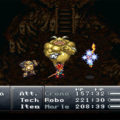SNES Retrospective Madness: Geoff’s Picks

It’s a testament to how great the Super Nintendo’s lineup was over the years that two writers on this blog were able to create lists with little overlap, including the “Honorable Mentions” sections. The lineup was so great, in fact, that they just as easily left enough for me to create my own list, even though I plan to name some of the same games in my own Honorable Mentions section. You could say that I’ve made the latter a designated cheating section, and that tracks.
This is a list driven by full nostalgia, so I made this a little tougher by keeping it to games I played on the SNES during its time on the market, excluding games I later played through emulation, ports to other platforms, or the SNES Classic Edition. The cheating section exists for a reason.

Street Fighter II Turbo
I mentioned how important Street Fighter II: The World Warrior was to the legacy of SNES fighting games in a slightly-lengthy feature last week, the game that started the craze. But it was Street Fighter II Turbo that perfected the formula it established. Turbo included the same twelve characters, though with the four bosses being playable without the use of the Game Genie, with better character balancing and massively improved speed. The speed was so perfect, in fact, that it made the previous game feel slow and sluggish in comparison, and made anyone who played it for hours upon hours on end wonder how they could have possibly tolerated it. The subsequent Super Street Fighter II was quality too, but Turbo edged it out thanks to its character balancing not being as polished. Not to mention that the home version of SSFII was a bit slower despite the speed being increased for the console port.

Super Mario RPG: Legend of the Seven Stars
The Mario franchise received spinoffs in a small number of genres by the mid-90s, but Super Mario RPG: Legend of the Seven Stars was the first foray into the Japanese RPG world. It helped show just how much potential lied in the series’ adaptation to a turn-based form, including new characters and a fun and somewhat reflex-based gameplay system wrapped in a clever sense of humor. It didn’t hurt that the game was handled by the best JRPG developers in the business in Squaresoft at the time. Super Mario RPG didn’t have the level of polish as its successors, and the battle system features felt like a rough draft for them in comparison, but that didn’t stop this game from being enjoyable and an important future blueprint.
Mega Man X
I will admit something blasphemous here: I didn’t think much of the original Mega Man games for a time when I was younger. The aesthetics and gameplay were too ostensibly bland and “kiddie” to me — which I didn’t discover was wrong and ignorant until actually playing one. Before that, Mega Man X spoke to me. This happened when I entered a phase where I liked “edgy” and “cool” stuff, and MMX’s harder and more 90s anime sci-fi aesthetic worked for me. It was edgier, but didn’t stray into peak 90s edginess –they needed teens and pre-teens to buy and play this. The additions of characters like Vile and Zero didn’t hurt, and X’s updated abilities compared to the original variant like dashing and wall jumping were too much fun to use. There were two more installments made for the SNES, but MMX had the tightest level and enemy encounter design of them.

Donkey Kong Country 2: Diddy’s Kong Quest
Donkey Kong Country instantly became one of my favorite platformers after I played it in 1994, a game I anticipated to an unhealthy degree (that I will not detail any further, thank you). Then came the sequel a year later, Donkey Kong Country 2: Diddy’s Kong Quest, a Capcom-style follow-up that used similar aesthetics and gameplay feel. That didn’t stop it from feeling like a sequel. The focus on Diddy and his sister Dixie Kong, and the levels designed around their abilities, made the levels an even larger joy to play through compared to the first game, with more challenging sections and clever secrets. This was the old DKC formula at its peak, something justifiably thought impossible after the first game.
(It also gave me another platformer to add to this list, since Angela featured the first game on her’s.)

Teenage Mutant Ninja Turtles: Turtles in Time
For anyone who enjoyed the NES Teenage Mutant Ninja Turtles brawlers, Turtles in Time on SNES was a godsend, even compared to the arcade version. The overall game had a different feel compared to the NES games and the arcade counterpart, with alternate hit effects and altered impact mechanics that made attacks from the Turtles and enemies feel stronger. This doesn’t sound like a big deal when described, but the feel of impact and audio feedback are more important for brawlers than most realize. Beyond that, the game offered more of what made the previous console brawlers work well, including solid levels (two of which were new for the home version), great music, and good encounter design. It’s a shame the SNES version didn’t retain four-player co-op feature from the arcade version thanks to hardware limitations, but it was still a better game.

Honorable Mentions
To no surprise, there were plenty more games released on SNES that I enjoyed, but weren’t added to the above list for multiple reasons. Super Metroid is one of my favorites, but there’s no need to write about it again when I just did so for the SNES-themed Quarantine Control not even a week ago. I played Final Fantasy VI/III on Super Nintendo after Final Fantasy VII thanks to being lucky enough to find a used copy when it became rare, but there’s no need to feature it on another list when Drew already did. I could not possibly write anything more about Chrono Trigger without regurgitating what I’ve written before. Yoshi’s Island: Super Mario World 2 is another favorite, but I played it first on Game Boy Advance and recently replayed it on the SNES Classic Edition.
The three lists we’ve made and other titles mentioned in this SNES Madness trip we’ve been on should convince anyone that the SNES was one of the best video game consoles in history, assuming they didn’t already realize it. It’s not just rose-tinted glasses doing the talking here. But all good things must end eventually. Just as support for the system had to end, the aforementioned Madness has a lifespan. Onto the next console Madness, then.





